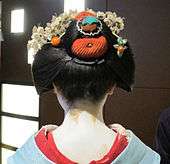Oshiroi
Oshiroi (白粉) is a powder foundation traditionally used by kabuki actors, geisha and their maiko apprentices. The word "oshiroi" literally means "white powder", and is pronounced as the word for white (shiroi) with the honorific prefix o-.
Description
Oshiroi is traditionally applied over a base of two types of wax used as a primer. Ishineri (石練) is applied to the eyebrows, whereas bintsuke (facial wax) is applied to cover the rest of the face and the neck; the upper portion of back is also covered if the wearer will be dressed in a susohiki (lit., "trailing skirt") kimono, where the upper half of the neck will be visible.
The oshiroi is mixed with water before being applied with a wide, flat brush over the neck, face and back. The oshiroi must be mixed carefully with water to achieve the right consistency, and can be difficult to achieve, as oshiroi that has too much moisture will not apply smoothly to the face, and oshiroi that has too little will crack and potentially fall off when worn.
Oshiroi is painted straight over the eyebrows, with the ishineri providing a smooth surface over the eyebrows to be painted over. The face is then powdered with rice powder, before the details around the eyes, eyebrows and mouth are drawn in.
Application

Application of oshiroi varies by occasion, use, and sometimes region (in terms of geisha and maiko).
Both geisha and maiko wear oshiroi on the face and neck, but application on the back of the neck differs per occasion. For most situations, a pattern knowm as eri-ashi (襟足) - lit., "neck stripes" - is worn, forming two triangular stripes of unpainted skin from the nape of the neck downward. For formal occasions, a three-stripe pattern known as sanbon-ashi (三本足) (lit., "three pointed stripes") is used.
Eri-ashi can be painted freehand with a smaller brush, but sanbon-ashi is generally painted using a stencil.[1] Both geisha and maiko, whilst aiming for a white-faced appearance, do not use a heavy application of oshiroi unless worn for special performances, instead blending the foundation into the skin with the use of a blusher, known as tonoko.
For geisha and maiko, application of oshiroi varies depending on age, status and region. Since the application of oshiroi can prove challenging, a younger maiko may have her oka-san (lit., "mother" - typically the mother of the geisha house) or her "older sister" geisha mentor apply it for her at first.
Younger apprentices may, in some regions, wear only oshiroi and blusher at the beginning of their apprenticeship to mark their inexperience, with the addition of black and red eyeliner at a later stage. Likewise, senior geisha tend not to wear any blusher, and wear oshiroi on fewer occasions over time, eventually wearing it only for special occasions and stage performances.
Some regional geisha trainees may apply oshiroi very lightly, whereas others in other regions may wear both a heavier application of oshiroi and differ in their use of blusher, red eyeliner and black eyeliner; this typically depends on both the inclinations of the mother of the house, and the general style of the geisha district.
Kabuki actors, in contrast, apply their oshiroi thickly, creating a bright white face visible from the furthest seats in the audience. A kabuki actor doing a quick change between characters may simply paint over their previous makeup, as oshiroi is opaque enough that previous makeup will not be visible.
History
In the past, the type of oshiroi used contained white lead, and would eventually give the wearer lead poisoning.[2] The use of white lead in makeup was outlawed in Japan in 1934.
References
- Ishihara, Tetsuo (2004). Nihongami no Sekai: Maiko no kamigata (The World of Traditional Japanese Hairstyles/Hairstyles of The Maiko) (1st ed.). Kyoto-shi, Japan: The Tetsuo Ishihara Museum of Traditional Japanese Hairstyles. pp. 66–70. ISBN 4990218604.
- Dalby, Liza (2000). Geisha (3rd ed.). London: Vintage Random House. p. 140. ISBN 0 09 928638 6.